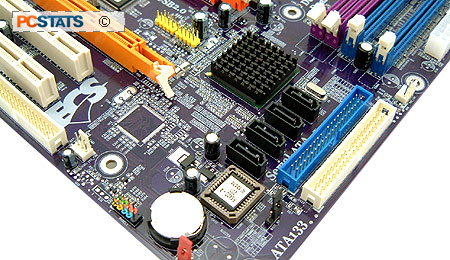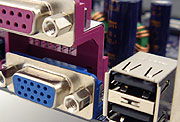ATi's
entry into the motherboard chipset market has been well... muted to say the
least. With its videocards, we're use to experiencing a lot of hype and
excitement in the days and months leading up to a product launch, but with ATi's motherboard
chipsets, there has been almost literally nothing.
I guess
it's easier to keep things mum when a company is not sure if its new
product will succeed in the market, rather than making a big fuss
and drawing attention to itself. Yet, this approach that ATI is
taking definitely does not show confidence in its motherboard chipsets. It's a shame too, ATi's
previous iterations Pentium 4 chipsets have been decent - even good when compared to other
System Integrator (SI) class solutions. Sure the ATI RS300 and RS350 chipsets lacked in the performance
department, but neither was really given much time to mature.
Perhaps ATi has grown accustomed to its dominance in the 3D videocard market,
leading it to expect immediate, and overwhelmingly positive results in the realm of core logic chipsets
too? It's hard to say for certain as this secretive company discloses
scant little about itself.
In any
event, PCSTATS always looks forward to the opportunity to test out new
technologies, or even motherboards based around uncommon chipsets like the
anonymous ATI 'RS400' Radeon Xpress 200. In this review we'll be testing out
the ECS
RS400-A motherboard, which supports 800MHz FSB LGA775 Intel Pentium 4 processors and offers
up PCI Express functionality.
 |
|
ECS RS400-A |
|
|

 |
| Includes: |
|
Users manual, Driver CD,
Ultra/133 IDE cable, Floppy cable, Serial ATA cable,
Molex |
 | | |
Actually,
the ECS RS400-A motherboard supports LGA775 Pentium 4 and Celeron processors
running on either the 800MHz or 533MHz FSB, but what really makes
this motherboard unique is that it has both a PCI Express x16 and physical
8xAGP slot. Other onboard goodies consist of a 10/100 network card, onboard
graphics care of the Radeon Xpress 200 chipset, support for either DDR or
DDR-2 memory, and 7.1 channel audio through the 'SB400' IXP400
southbridge.
 All of this comes together to make the ECS
RS400-A motherboard one very flexible purple solution capable of bridging the gap between old
and new technologies. If you have been wanting to jump into a Socket 775 processor, this
might be your opportunity to do so without much cost...
All of this comes together to make the ECS
RS400-A motherboard one very flexible purple solution capable of bridging the gap between old
and new technologies. If you have been wanting to jump into a Socket 775 processor, this
might be your opportunity to do so without much cost...
The
general layout of components and connectors on the RS400-A
is logical, although I prefer not to have the floppy drive connector at the bottom
of the board. I liked how ECS has a main ATX power supply retention notch
for both 24 pin and 20 pin power supplies. Pulling the power supply cable out of
this motherboard will be difficult.
Despite a large heatsink on the ATI RS400 Northbridge and
small one on the SB400 Southbridge, the ATi chipsets actually
do not produce much heat. It's a pleasant change compared to Intel
and nVIDIA offerings which can be like little infernos.

The IXP 400
southbridge supports first generation Serial ATA devices, though it is nice to see the locking-style serial ATA
headers are used. These ones are a lot more secure, and the cables will
not pop out at the slightest touch... as long as you can find them. ECS includes
just one SATA cable with this board.
Aside
from the floppy drive connector placement, the only other minor thing that
bothered me was the PCI Express x16 retention lock.  The one that is found on the RS400-A is extremely
difficult to access when a videocard is installed. If you can get
your fingers down there, unlocking the videocard is a frustrating task. I found
it easier to pull the videocard out from the front, rather than to unlock and remove
the videocard regularly. The 8XAGP slot had a regular style lock.
The one that is found on the RS400-A is extremely
difficult to access when a videocard is installed. If you can get
your fingers down there, unlocking the videocard is a frustrating task. I found
it easier to pull the videocard out from the front, rather than to unlock and remove
the videocard regularly. The 8XAGP slot had a regular style lock.
ATi is
well known for its excellent 2D image
quality, but I was surprised to see rather less than that coming from the integrated videocard
on the RS400-A. On a 19" LG Flatron 995FT Plus CRT monitor used for
testing, text and fine lines overall were somewhat blurry and difficult to read. Installing
a standalone videocard improved things dramatically, so if you're working
mainly with 2D applications it's worth while to use a real videocard
here.

